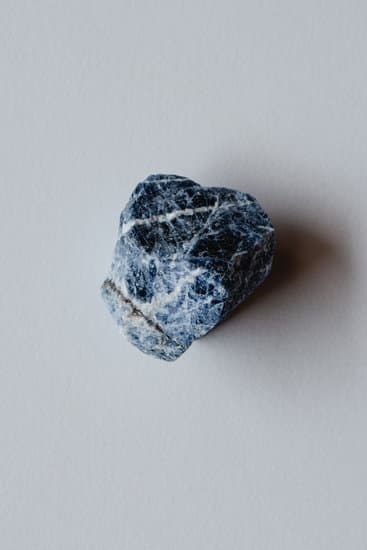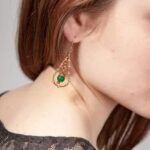Art deco jewelry elements are prominent features of various jewelry styles, including rings, necklaces, and earrings. Originating from the earliest form of art deco in the early 1900s, art deco elements evolved from a combination of ancient geometrical shapes merged with modern trends to create a distinct style of glamor.
Alongside its recurrent use of bold colors, art deco jewelry began utilizing geometrical shapes found in Egyptian and Greek art such as rectangles, triangles and circles for effective visual effects. These elements have since been integrated into a myriad of materials rarely seen before its era such as platinum set with diamonds and colored gems or precious metals featuring unique motifs made out of manmade or organic materials.
In addition to the geometric objects used in Art Deco jewelry designs, they also often include symbolic graphical designs representing movement and speed. Another common motif is the zig zag line that can be seen on many of the pieces; this unique design was said to represent electricity which was seen at the time as modernity due to its technological advancement during this period.
Art deco elements were also characterized by their utilization of different cut versions of diamonds popularized as ‘baguettes’ or ‘steps’. Last but not least, motifs like salamanders clasping their own tails were said to signify eternity if designed symmetrically.
Origins & History of Art Deco Jewelry
The Art Deco movement began in the early 20th century, primarily in France and Italy. Initially, Art Deco focused on geometric shapes and streamlined curves, combining past styles such as neoclassicism and modernism to form a unique combination of modern art. This aesthetic influenced art, architecture, and design during this era.
Beginning in the 1920s, it quickly spread throughout Europe and North America where it had an important impact on many forms of design including jewelry. During this period, artisans combined precious metals such as gold and platinum with vibrant gemstones like sapphires, rubies, diamonds, and emeralds to create works of stunning beauty.
René Lalique was one of the most influential jewelers of this period. He worked extensively with molten glass in addition to gold and other gems in order to create pieces that were both beautiful and highly functional as modern accessories.
He incorporated his own series of artistic motifs which include goddesses and nature scenes which exemplify the boldness with which he approached his craft. Popular designs of his included ornate necklaces featuring complex chains bedecked with stones; his trademark wildlife-themed pieces remain sought after today.
Italian jeweler Elsa Schiaparelli also contributed greatly to the development of Art Deco jewelry. Her penchant for surprise elements made her jewels truly unique; one piece could sport a variety of different devices like charms or brooch pendants shaped like snakeskin or even insects. She was famous for her overblown rings – designed using large stones set against tiny ones – as well as chunky bangles that matched her bold wardrobe choices.
All these elements created a whimsical conversation between the materials used while still keeping its traditional roots intact. As she said “If you want something dull you go somewhere else”. Pieces like these helped develop imaginative trends popularized during this period which continue to be seen today.
Art Deco jewelry continues to influence modern day design; however it was during this period when artisans began exploring new ways to combine materials into unexpected combinations, creating timeless works of art that can often be seen adorning celebrities today such as Priyanka Chopra Jonas who is considered a jewelry connoisseur herself owning many statement pieces from Cartier which can rightly be attributed to the historic Art Deco movement for setting jewelry trends for centuries ahead.
Characteristics of Art Deco Jewelry
Art Deco jewelry is known for its distinct characteristics, which make it stand out among the traditional and contemporary jewelry styles. The most common materials used in Art Deco jewelry are platinum, gold, silver and enamel. Designs often include geometrical shapes, linear patterns and lines that embraced the new technology of the time period.
Art Deco pieces incorporated bold colors like deep blues, reds, orange and purple to help set them apart from other jewelry designs. There was a heavy influence of nature found in pieces such as flowers or animals.
Art Deco jewelry has also become renowned for its wide variety of colors seen in stones and shapes used to create each piece. Rhodolite Garnet and Tanzanite were just some of the many vibrant colors available during this era. Cabochons were popularly used in necklace pendants while chokers featured circular or crescent-shaped pendants. Clips featured symmetrical forms while earrings had intricate floral designs with dangling drops that brought attention toward the face flattering the wearer’s curves too.
The overall goal of Art Deco designers was to create something drastically different from any other style seen before. They wanted to express modernity by combining ornate detailing and pearls along with sapphires, rubies or even marcasite to achieve a grand appearance without being overly extravagant.
Also, gold was a preferred choice when it came to larger pieces of statement jewelry such as necklaces or bracelets intended for eveningwear occasions that would typically accompany glamorous evening gowns or fancy dinner dresses. As a result, Art Deco jewelry serves both aesthetics and practical use offering unique adornments for any kind wardrobe need regardless of time period boundaries.
Popular Elements & Symbolism of Art Deco Jewelry
Art Deco jewelry is one of the most popular and well-known antique jewelry styles. The style, which originated in Paris in the 1920s and was robust into the 1930s, is characterized by geometric shape and bold lines creating brilliant stepped designs.
One of the most recognizable elements to Art Deco jewelry is its usage of gemstones and playful combinations of coloured metals like white, yellow and rose gold. Although each piece carries some individuality, there are also common designs that were used as motifs in Art Deco era jewelry.
Geometric shapes including loops, circles, semi-circles, rectangles and squares were key features in many pieces of Art Deco Jewelry. These shapes can often have intricate designs carved or filigreed into them for a more ornamental look and feel.
Furthermore, animals such as lions, birds and snakes with sinuous bodies and beaded eyes often featured on rings, necklaces and bracelets. This gave the pieces a lavish journey feel with sleek lines that balanced movement with strait-edged structure for an undeniable sense of luxury.
Another significant element to Art Deco period Jewelry is its use of opulent stones such as rubies, sapphires, diamonds and emeralds that provided a striking contrast against both white & yellow metals used to create their settings. In addition to these materials vibrantly colored glass was also utilized – a technique borrowed from techniques employed by jewelers during the Egyptian period much earlier.
Colored cabochons would enhance floral patterns while special cuts could add texture or highlights with fringe that may appear around larger gemstones adding definition without overwhelming their dazzling brilliance.
In conclusion this style of exquisitely designed artwork reached its heyday during the roaring twenties before WWII broke out – though it’s far from gone today. Reproductions are plentiful allowing vintage purists to enjoy authentic antiques while modern fashion enthusiasts access similar aesthetics with brand new creations all across Europe & America.
Variety of Art Deco Earring & Necklace Designs
Art Deco jewelry designs feature a distinct look – elegant, geometric shapes like squares and rectangles as well as bold lines and stylish flourishes. While the Art Deco style is often associated with the 1920s, it continued to be popular through to the 1940s, when ornate rhinestone jewelry was particularly prominent. With a wealth of variations and styles, Art Deco jewelry can make each piece unique – ranging from finely detailed earrings to bold statement necklaces.
Perhaps one of the most iconic elements of Art Deco jewelry is its use of geometric subjects. Shapes such as diamonds, triangles and chevrons often feature in these styles of earrings or necklaces. By contrasting different shaped stones together, an interesting visual interest can be created.
To further enhance this visual impact, some designers choose to add additional details like bold engraving or intricate patterns onto the stones themselves. Asymmetrical elements are also seen in many designs; sometimes featuring creative combinations of multiple metals or colorful stones placed at uneven points across a design.
In addition to its unique form factor, Art Deco jewelry also features plenty of flawless finishes that bring out shimmering colors for maximum effect. From glossy enamel to polished metals and luminous gemstones, each piece of jewelry reflects a gorgeous spectacle that combines vintage glamour with modern chicness.
Varieties like round brilliant cut diamonds offer extra sparkle along with intricately cut settings. These attributes come together to create an unforgettable look that’s able to set any outfit apart in all kind of events – from formal galas to more intimate soirees among close friends and family members.
Adornment of Jewelry to Achieve a Unique Look
Art Deco Jewelry has a wide range of distinct elements that can be used to add a personal touch to any look. Whether it’s through intricate designs, bright colors, or sleek silhouettes, Art Deco Jewelry embraces the opportunity to create something truly unique.
The appeal of Art Deco is its emphasis on modernism and luxury. This style combines various materials such as gold, silver, enamel, glass, ceramic and even wood. The use of geometric shapes also helps enhance the modern vibe by adding boldness and contrast. Some common Art Deco inspiration comes from animals, architecture and plants, making each piece its own work of art.
For those looking to make a statement with jewelry without going overboard with color or bling factor, Art Deco gives them the chance to combine pieces in order to make something much more special. Combining various pieces together can easily create an item that is one-of-a-kind and ideal for special occasions or everyday wear.
To do this effectively requires knowing what works best with different elements like metal type, gemstone type/quality as well as which ones will stand out for the given look. With this knowledge and some creativity there’s no limit to what can be achieved when designing one’s own jewelry collection.
Another interesting aspect of Art Deco Jewelry designs is how they can be interpreted differently depending on who your audience is. Whether you are looking for more modern elegance or want something bolder that expresses your individual style – using combinations of different components along with careful mixing designers often find themselves able to craft custom jewelry pieces that inspire others in many ways depending on who’s wearing it.
In other words, it’s often not just about how much money was spent but rather having an iconic design with timeless appeal. It’s this versatility that separates Art Deco from all other styles today – making it truly for everyone in whatever flavor or form they choose.
Care & Maintenance for Art Deco Jewelry Pieces
When it comes to caring for Art Deco jewelry pieces, the most important thing to remember is that each and every piece of jewelry is different and requires a unique approach. Depending on the individual item and its age and materials, proper care and maintenance can make an incredible difference in preserving their beauty for years to come.
Since Art Deco jewelry is often made with delicate metals such as gold and platinum, it’s important to take extra special care when handling them.
To ensure your treasured pieces are properly looked after, there are several steps you can take. Firstly, avoid direct contact with water unless a professional jeweler or specialist advises otherwise. Additionally, certain metal polishes can cause damage so only use those recommended by a qualified specialist.
A great way to keep your jewelry safe is to store it individually in a pouch or case that limits its exposure to other objects which could cause potential damage. Try not to store items such as pins or buckles next to soft gems like pearls or turquoise; these materials are far more delicate than harder stones like diamonds or rubies and may be prone to scratches if put into contact with rougher materials.
When wearing your Art Deco jewelry pieces, always remove any items before engaging in any strenuous activity – this includes lifting heavy objects or participating in any kind of physical activity as vibration and jarring motions can damage the piece or even loosen any settings that hold stones or findings together.
Most importantly, if you notice any signs of wear-and-tear on any pieces then take them in for a thorough inspection so they can be safely taken care of by a skilled professional.
With these tips for proper care & storage of your heirloom pieces you’ll find that investing the time now will lead to plenty of enjoyment from admiring your beloved jewelry today and into future generations.
How to Wear Art Deco Jewelry for Maximum Impact
Art Deco jewelry has rapidly become popular in fashion circles; its bold, eye-catching designs and vibrant colors provide an added layer of sophistication to any outfit. But there’s more to this trend than just looking good – knowing how to wear Art Deco jewelry for maximum impact is the difference between a subtle look and one that truly stands out. When done correctly, pairing your wardrobe staples with timeless Art Deco pieces can create a chic and timeless statement.
One way to showcase your love for Art Deco style is to create a color-based look by incorporating statement pieces into an all-neutral outfit. For example, if you’re wearing a beige blouse and wide leg jeans, add a few delicate Art Deco earrings or an ornate necklace to complete the look.
From sapphire blues to golden yellows, these bursts of color will contrast nicely against neutrals while immediately capturing attention on its own. A great tip: opt for large pieces with geometric shapes as they particularly evoke the classic 1920s era that the trend derives from.
If you’d prefer something bolder, try taking it up a notch by layering multiple pieces together at once. Statement earrings paired with eye-catching rings or pendant necklaces make quite the impression when layered with other standout items such as brightly colored scarves or ties.
Not only does this give you more control over the creative process of crafting your look, it also allows you to take advantage of all sorts of shapes and finishes found in Art Deco jewelry. To really maximize your ensemble, pair colorful patterned pieces with those featuring vibrant gemstones; this combination projects intense appeal which makes for unforgettable attire no matter where one goes.
At the end of the day, choosing how to wear Art Deco Jewelry comes down personal preference; whether opting for simple looks like monochrome color palettes or rockin’ multiple layers in full force – anything goes. Ultimately incorporating these timeless pieces into casual or dressy ensembles can easily elevate any outfit so long as you keep creativity & confidence at heart when playing around with styles & hues alike. Who knows?
With enough experimentation & willingness to explore new combinations every now and then – who knows what kind of head turning style originality lies in wait? Time spent scouring vintage stores in search for mood lifting finds are often well worth going that extra mile – especially when Amour from first sight strikes.

Welcome to my jewelry blog! My name is Sarah and I am the owner of this blog.
I love making jewelry and sharing my creations with others.
So whether you’re someone who loves wearing jewelry yourself or simply enjoys learning about it, be sure to check out my blog for insightful posts on everything related to this exciting topic!





